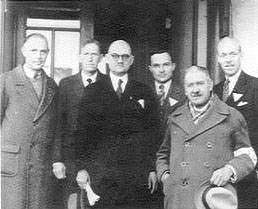
Back Comité international de la zone de sécurité de Nankin French Comitato internazionale per la zona di sicurezza di Nanchino Italian 南京安全区国際委員会 Japanese Den internasjonale komité for Sikkerhetssonen i Nanjing NB

| This article is part of the series on the |
| Nanjing Massacre |
|---|
| Japanese war crimes |
| Historiography of the Nanjing Massacre |
| Films |
| Books |
The International Committee was established in 1937 to establish and manage the Nanking Safety Zone.
Many Westerners were living in the city at that time, conducting trade or on missionary trips. As the Imperial Japanese Army began to approach Nanjing (also known as Nanking), most of them fled the city.[1] A small number of Western businessmen, journalists and missionaries, however, chose to remain behind. The missionaries were primarily Americans from the Episcopal, Disciples of Christ, Presbyterian, and Methodist churches. To coordinate their efforts, the Westerners formed a committee: the International Committee for the Nanking Safety Zone.
German businessman John Rabe was elected as its leader, partly because of his status as a member of the Nazi party, and the existence of the German–Japanese bilateral Anti-Comintern Pact. Rabe and other refugees from foreign countries tried to protect the civilians from being killed by the Japanese. The Japanese army did not completely respect the immunity of the Safety Zone and soldiers would sometimes show up under dubious pretenses to take Chinese women and men into custody. There were also kidnappings of women from the Zone. Such people taken into custody would often either be summarily executed or taken away for rape.[2] Due to Rabe's efforts some 250,000 people were protected during the Nanjing Massacre.
In February 1938, as violence by the Japanese Army abated, the International Committee for the Nanking Safety Zone was reorganized as the Nanking International Relief Committee, which did humanitarian work in Nanjing until at least 1941. There are no records of any activity by the committee after 1941 and it is believed that it was likely forced to discontinue its operations after the United States entered World War II.[3]
- ^ David Askew (April 2002). "The International Committee for the Nanking Safety Zone: An Introduction". Sino-Japanese Studies. 3.
- ^ Chang, Iris (1997). The Rape of Nanking: The Forgotten Holocaust Of World War II. Basic Books. p. 134. ISBN 0465068359.
- ^ David G. Kim (1988), Missionaries at War: The Humanitarian Effort of the Nanking International Relief Committee During the Sino-Japanese War, 1937–1945, unpublished Yale University senior thesis, pp. 44–45
© MMXXIII Rich X Search. We shall prevail. All rights reserved. Rich X Search